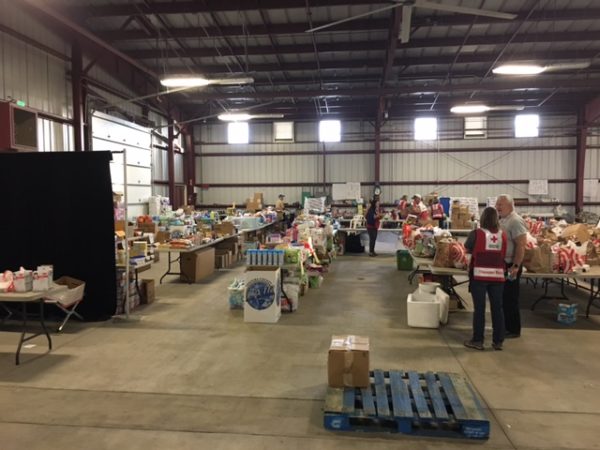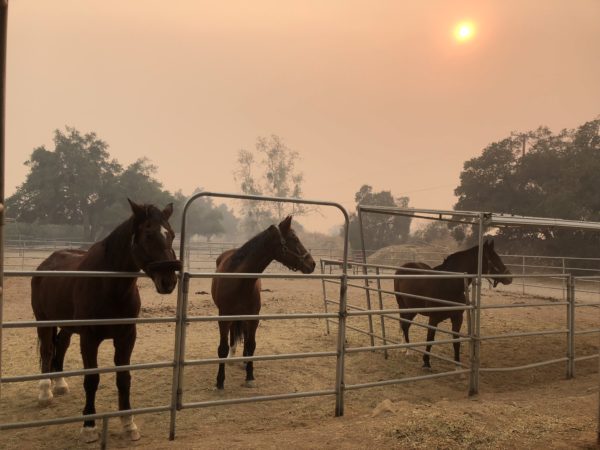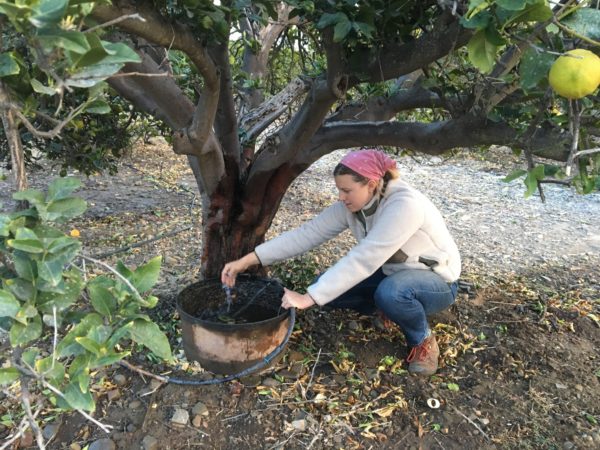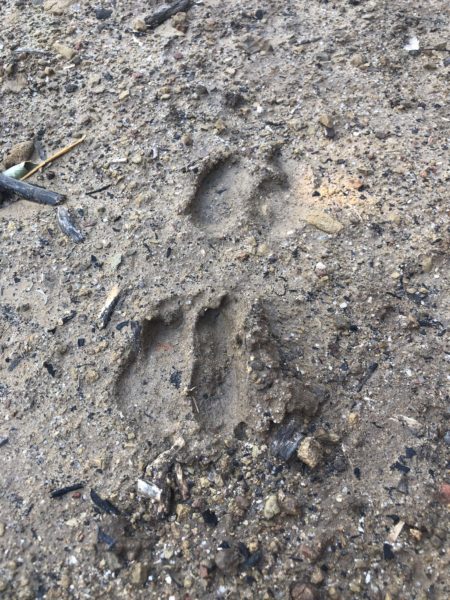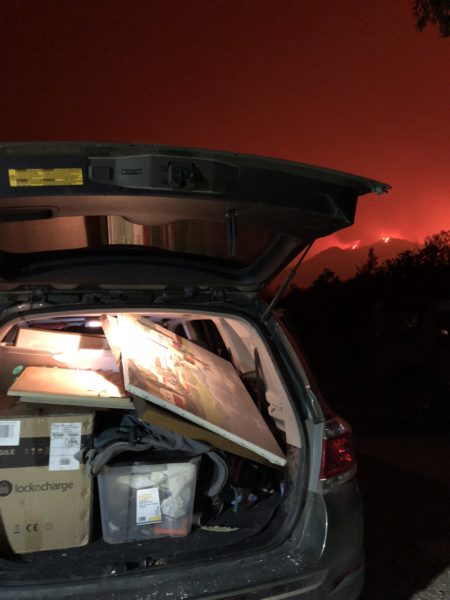Laguna Canyon Foundation is blessed to work with kind and generous volunteers, board members and staff. During the Thomas Fire, two of our own spent days in Ojai and Ventura doing what they could to help.
The call came in …
Laguna Canyon Foundation volunteer and Laguna Beach resident John Monahan has served as a Red Cross DAT (Disaster Action Team) Lead for more than three years. The Red Cross and its army of volunteers are poised 24/7/365 to assist and comfort residents when disaster strikes: fires, mudslides, cars running into their homes, earthquakes.
Most of the year, John shares a weekly schedule to be on call for local (Orange County) emergencies. This means, says John, “When I get the call, I try to make sure Red Cross volunteers are with the clients within an hour of the call to help them through these difficult days. We are focused on the individuals in their time of need to provide a variety of possible resources and services: money for lodging, clothes, blankets, food, prescription and medical equipment replacements, spiritual care and/or mental health services. A Red Cross case worker will follow up to see how the recovery is going.” Calls usually come in from first responders such as firefighters and police.
When the Thomas Fire hit, the Red Cross’s DRO (Disaster Relief Operation) was elevated to a national operation. Red Cross chapters which are local to the Ventura/Ojai area were called first, but as John explained, “The fire was so massive and so much help was needed, I was soon working shoulder to shoulder with Red Cross volunteers from Long Island and Bainbridge.”
As with local operations, the Red Cross volunteers were focused on the immediate needs of displaced victims. “We managed the shelter at the Ventura Fairgrounds and provided food, clothing, personal items and support to more than 300 people,” said John.
For the first three days, the volunteers stayed in a church gymnasium. One hundred and fifty volunteers shared a space with just a few toilets and sinks and no showers. “That was a bit tough — a lot of snoring, sweating, and noisy shift changes,” said John, “but then we were moved to Port Hueneme Naval base apartments which, of course, had showers and actual beds.” The Naval base, which became John’s home away from home for the next ten days, was about a 20-minute drive from the Ventura Fairgrounds.
“The smoke was a constant problem. As the fires moved north, the smoke continued to waft down through the Ojai River,” said John. “We were all wearing masks.”
The volunteers reported daily for 12-hour shifts. John’s specific assignment was to manage unsolicited donations. This included traffic control (cars lined up to donate), triaging donations that were useable for the current situation and donations that needed to be stored for further sorting, and securing a warehouse for the donations that couldn’t be used at the Fairgrounds.
This was a huge task, and at one point, when John was directing the line of cars, a woman pulled up with 30 – 40 bags of miscellaneous donations and several cases of water. She parked her car and helped unload her bags into the Red Cross’ U-Haul truck in an effort to keep the queue of cars moving. The air was thick with smoke. As her last bag was unloaded and she got in her car, she realized she no longer had her keys. “All of the volunteers looked stricken as we surveyed the long line of cars and wondered how long it would take to unload the fully loaded U-Haul to find her keys. As it turned out,” said John, “we found her keys which had slipped between two water cases and she was quickly on her way.”
“People like to donate material goods because they feel a closer personal connection to the people in the shelter. But it’s often very difficult to match the shelter needs with the donations. We probably received 25 – 50 times the amount of baby care items, bottled water and used clothing than was needed. Ultimately, the donations will be used, but probably not during the actual disaster at hand.
“Overall, the best advice I have is to donate money for all the facilities, food, bedding, vehicles, volunteer transportation and housing or, to make it more personal, donate time. We really appreciated all the people who came out to the Fairgrounds to help,” said John.
Because Red Cross policy requires that the perishable food served in shelters be from a commercial or professional kitchen, each local Red Cross chapter has agreements in place with vendors to provide food in case of a disaster. Food was brought in daily to the Fairgrounds and included pizza, Mexican food, sometimes even hot food from a mobile kitchen.
The Ventura Fairgrounds also had stables, which made it convenient to house pets and animals.
“It’s amazing the kind of details that go into an operation like this and I’m proud to be a part of the Red Cross. Most of us have never experienced a disaster,” says John. “That’s why I volunteer with the Red Cross, because it’s very gratifying to have the resources and experience to help when people need it most.”
“Ojai is where I’m from ….”
Laguna Canyon Foundation’s Outreach and Restoration Coordinator, Cameron Davis, grew up in Laguna Beach. But having lived her high school years at Ojai Valley School, hiking, camping and learning in the hills of Ojai Valley, it’s hard for her not to think of herself as an Ojaian. She also met the love of her life, James, at Ojai Valley School, and although the two now live in Laguna Beach, they still have many family members and friends in Ojai.
On a hot, dry Tuesday in December, as she prepared to lead 60 third graders on a hike to Barbara’s Lake, Cameron got a text from James. She needed to leave immediately to go up to Ojai. James had already left his La Mirada office and was on the 101 heading north. James’ father’s property was threatened by a fast-moving fire. He was packing his two cars and needed help. Also threatened was “The Ranch,” a citrus and avocado grove home to several horses, goats and animals, as well as many of Cameron and James’ family and friends.
Ojai Valley is rural, with a history of ranching. The Valley has a population of about 30,000 and has only three ways out. It is a small town, much like Laguna Beach.
Cameron ran home to grab clothes for James. She also grabbed whatever else seemed appropriate: water and cans of beans. She dropped their dogs off at her mother’s in North Laguna. Thankfully, since Cameron was preparing to hike that day, she was wearing appropriate clothing for the days ahead, because she didn’t end up getting clothes for herself.
James and Cameron met in Ventura to drop off James’ car “… at the safest place we could think of,” said Cameron, “the Patagonia store’s parking lot right under the security camera.” They picked up more water and headed east on the 33 toward Ojai. “There were no cars going into Ojai, just ours, and there was a line of cars leaving.”
James’ father, John, had already left his property on Ojai’s west side and headed east to what was a safer spot for the moment, the Ranch. James and Cameron’s first order of business was to pick up John’s second car and move it to the Ranch. “The neighborhood was eerily empty; there was smoke everywhere. John’s house wasn’t locked,” said Cameron.
The Ranch fast became a central place for family and friends — as many as 12 people at a time — to huddle together for the next few days, determined to protect the property and animals. “One of my high school teachers lives on the Ranch and she was not going to leave the animals and we were not going to leave her.
“For most of the time, we had electricity, giving us access to the news on the radio and the TV,” said Cameron, “but the coverage quickly moved to the Ventura fires, so we had little knowledge of how near the fires were to us.”
Enter #OjaiFire, @OjaiFire, and @CALFire. “I would have never guessed it, but aside from our ham radio, Twitter ended up being our best source of information. From tweets, we could better assess where the fires were.”
“Citrus doesn’t burn.” Old adage? Fact? Whatever the case, the Ranch was surrounded by citrus and it was a truth the group wanted to believe. “We hiked up from the Ranch to the highest point where we saw so many hot spots. The hills where we had camped over the years were covered in ash. Many streets and homes familiar to us were burned down; the air was thick with smoke.”
The days and dangers blurred together for Cameron as she retold her story. At one point, she recalled, the fire quickly turned, and now it appeared the Ranch’s east end was in danger and John’s house on the west side seemed safer.
James told the group it was time to leave, but many wouldn’t. “Citrus doesn’t burn” and they weren’t leaving the horses. James took Cameron, three dogs and three cats and drove the ten miles to his father’s home, only to return to the Ranch a few hours later as the fires took yet another turn. At this point, John’s house was still standing, although other houses on the street had burned down.
Throughout the days James and Cameron were in Ojai, the fires continued their erratic behavior. “We just lived and survived and monitored the news on Twitter and through our ham radio. We helped friends move belongings. We moved pets to safer places. We ate the beans I brought and made do with what food we could find; the Ranch work still needed to be done, so we fed the animals, worked on the irrigation in the groves, and cleared brush away from the structures,” said Cameron.
In many ways, Cameron’s Laguna Canyon Foundation restoration experience of planting, weeding and watering in our local wilderness assisted her. “If it wasn’t for all the smoke, it almost felt like at times, I was at ‘work.’ It was comforting to be productive.”
Cameron also made it a point to fill big tubs of water on the Ranch edges to potentially help the wildlife — and it worked. “We saw deer, bear and coyote tracks leading to the tubs.”
One day, Cameron and James ventured out to town to see what businesses might be open. Most were closed, but a coffee shop — and the location of James’ and Cameron’s first date — “Full of Beans” was open. They picked up coffee and muffins to take back to the Ranch. On the way back, they ran into an exhausted firefighter. He had come from Oakland and had been up for 24 hours. “Want some coffee?” James offered. At the word, two more firefighters came out of the smoke, and soon, James and Cameron were giving the firefighters all they could offer them: coffee and muffins.
Back at the Ranch, the group soon got word that Ojai Valley School had suffered much damage. The new tech center and many offices were burned and data was lost. The girls’ dorm where Cameron had spent three years of her life was burned to the ground, with only a brick chimney standing.
Staying until they knew their family was safe and grateful to know that John’s house, the Ranch, and the animals were all saved, James and Cameron made the tough decision to leave on the sixth day. “There was so much still to be done, but we had our jobs and dogs and life back in Laguna Beach.”
“Oak doesn’t burn.” Adage? Fact? When asked about a specific memory of her experience, Cameron recalls, “I was looking out into the wilderness surrounding the valley … nothing but white ash, a place that I cherish, where I grew up and developed my love for the wilderness, a place full of chaparral, now a total moonscape, except for one massive oak tree. Not one leaf was burned, just a little scorching on the trunk.”
When asked for advice to share with others about their experience, both John and Cameron said to get your to-go bag together now. Put important photos and documents on a thumb drive and/or the cloud. Create a plan with your family and for your pets. Imagine going through a disaster without your phone and car. Be prepared. When you’re told to evacuate, leave.

